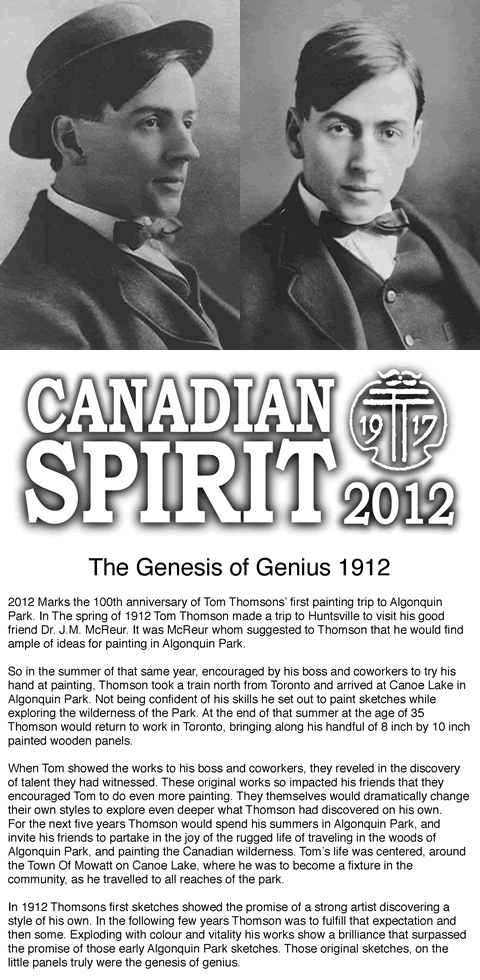Group of seven outdoor gallery - The Group Of Seven

Tom Thomson and The Group of Seven were spurred on by the ideals of Algonquin Park and the Canadian Northland. This group of friends ventured into the wilderness as voyageurs with their canvas and paints discovering their expression for their Canadian ideals in art. They met while working as commercial artists at various Toronto printing firms where they specialized in graphic design for advertisements. On weekends they would take sketching trips together, painting scenes around the city and discussing the art world.
In the summer of 1912 after visiting Huntsville that spring, Tom Thomson went to Algonquin Park to paint the landscape. Upon his return, his friends were so inspired by the work he created there they started to join his annual summer sketching trips to Algonquin Park. They would spend a few weeks inside the park canoeing, portaging and painting the scenery. A common thread was beginning to take shape in their works and discussions of art abounded.
At this time painting outside the accepted realm of realism was critically rejected and shunned by most art dealers in Canada. These painters set out to stretch the limitations and restrictions facing Canadian artists, and their works and ideals sparked debates about a new art form; a conflict that would last twenty years.
In 1917 during World War I these friends were scattered across the globe. Some were hired by the Canadian War Records Department to paint the actions of the Canadian troops in Europe. Thomson being ineligible to go into military service spent that summer in Algonquin Park. In previous years he had been a ranger, fire fighter and guide, but found that these activities interfered with his ability to produce more work. Thomson intended to paint one painting every day to document the changing of the seasons in paint, however he drowned in Canoe Lake, Algonquin Park on July 8th, 1917. The news of his tragic death devastated his companions who saw it as a great light extinguished in the world of art.
After WWI the artists reconvened in Toronto and formed a collective called the Group of Seven to put up a front to the negative reactions to their work. Their first show was in 1920 and included some of Thomson’s canvases. The Group spread out painting all corners of Canada and uniting the nation through their art. With the passing of founding member J.E.H. MacDonald in 1932, the Group disbanded leaving an indelible mark on the Canadian psyche.
The Group of Seven’s works are a legacy to our Canadian cultural identity. Algonquin Park was their school and spawning ground. They inspired generations of young artists to experience the wilderness of expressive freedom. Their story and struggle to change the opinion of what art should be was inspired by their high spirited camaraderie and their belief in Canada as a young and vital country.
Gerry Lantaigne (Artistic director - The Group of Seven Outdoor Gallery)
In the summer of 1912 after visiting Huntsville that spring, Tom Thomson went to Algonquin Park to paint the landscape. Upon his return, his friends were so inspired by the work he created there they started to join his annual summer sketching trips to Algonquin Park. They would spend a few weeks inside the park canoeing, portaging and painting the scenery. A common thread was beginning to take shape in their works and discussions of art abounded.
At this time painting outside the accepted realm of realism was critically rejected and shunned by most art dealers in Canada. These painters set out to stretch the limitations and restrictions facing Canadian artists, and their works and ideals sparked debates about a new art form; a conflict that would last twenty years.
In 1917 during World War I these friends were scattered across the globe. Some were hired by the Canadian War Records Department to paint the actions of the Canadian troops in Europe. Thomson being ineligible to go into military service spent that summer in Algonquin Park. In previous years he had been a ranger, fire fighter and guide, but found that these activities interfered with his ability to produce more work. Thomson intended to paint one painting every day to document the changing of the seasons in paint, however he drowned in Canoe Lake, Algonquin Park on July 8th, 1917. The news of his tragic death devastated his companions who saw it as a great light extinguished in the world of art.
After WWI the artists reconvened in Toronto and formed a collective called the Group of Seven to put up a front to the negative reactions to their work. Their first show was in 1920 and included some of Thomson’s canvases. The Group spread out painting all corners of Canada and uniting the nation through their art. With the passing of founding member J.E.H. MacDonald in 1932, the Group disbanded leaving an indelible mark on the Canadian psyche.
The Group of Seven’s works are a legacy to our Canadian cultural identity. Algonquin Park was their school and spawning ground. They inspired generations of young artists to experience the wilderness of expressive freedom. Their story and struggle to change the opinion of what art should be was inspired by their high spirited camaraderie and their belief in Canada as a young and vital country.
Gerry Lantaigne (Artistic director - The Group of Seven Outdoor Gallery)
